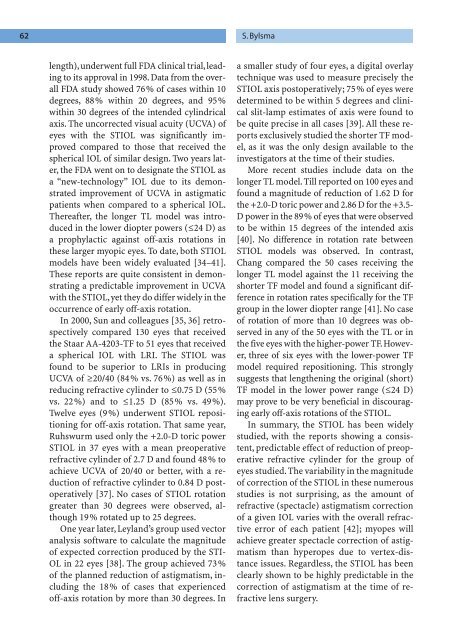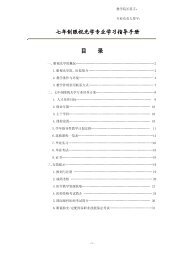Refractive Lens Surgery
Refractive Lens Surgery
Refractive Lens Surgery
You also want an ePaper? Increase the reach of your titles
YUMPU automatically turns print PDFs into web optimized ePapers that Google loves.
62 S. Bylsma<br />
length),underwent full FDA clinical trial,leading<br />
to its approval in 1998. Data from the overall<br />
FDA study showed 76% of cases within 10<br />
degrees, 88% within 20 degrees, and 95%<br />
within 30 degrees of the intended cylindrical<br />
axis. The uncorrected visual acuity (UCVA) of<br />
eyes with the STIOL was significantly improved<br />
compared to those that received the<br />
spherical IOL of similar design. Two years later,<br />
the FDA went on to designate the STIOL as<br />
a “new-technology” IOL due to its demonstrated<br />
improvement of UCVA in astigmatic<br />
patients when compared to a spherical IOL.<br />
Thereafter, the longer TL model was introduced<br />
in the lower diopter powers (£24 D) as<br />
a prophylactic against off-axis rotations in<br />
these larger myopic eyes. To date, both STIOL<br />
models have been widely evaluated [34–41].<br />
These reports are quite consistent in demonstrating<br />
a predictable improvement in UCVA<br />
with the STIOL,yet they do differ widely in the<br />
occurrence of early off-axis rotation.<br />
In 2000, Sun and colleagues [35, 36] retrospectively<br />
compared 130 eyes that received<br />
the Staar AA-4203-TF to 51 eyes that received<br />
a spherical IOL with LRI. The STIOL was<br />
found to be superior to LRIs in producing<br />
UCVA of ≥20/40 (84% vs. 76%) as well as in<br />
reducing refractive cylinder to £0.75 D (55%<br />
vs. 22%) and to £1.25 D (85% vs. 49%).<br />
Twelve eyes (9%) underwent STIOL repositioning<br />
for off-axis rotation. That same year,<br />
Ruhswurm used only the +2.0-D toric power<br />
STIOL in 37 eyes with a mean preoperative<br />
refractive cylinder of 2.7 D and found 48% to<br />
achieve UCVA of 20/40 or better, with a reduction<br />
of refractive cylinder to 0.84 D postoperatively<br />
[37]. No cases of STIOL rotation<br />
greater than 30 degrees were observed, although<br />
19% rotated up to 25 degrees.<br />
One year later, Leyland’s group used vector<br />
analysis software to calculate the magnitude<br />
of expected correction produced by the STI-<br />
OL in 22 eyes [38]. The group achieved 73%<br />
of the planned reduction of astigmatism, including<br />
the 18% of cases that experienced<br />
off-axis rotation by more than 30 degrees. In<br />
a smaller study of four eyes, a digital overlay<br />
technique was used to measure precisely the<br />
STIOL axis postoperatively; 75% of eyes were<br />
determined to be within 5 degrees and clinical<br />
slit-lamp estimates of axis were found to<br />
be quite precise in all cases [39]. All these reports<br />
exclusively studied the shorter TF model,<br />
as it was the only design available to the<br />
investigators at the time of their studies.<br />
More recent studies include data on the<br />
longer TL model. Till reported on 100 eyes and<br />
found a magnitude of reduction of 1.62 D for<br />
the +2.0-D toric power and 2.86 D for the +3.5-<br />
D power in the 89% of eyes that were observed<br />
to be within 15 degrees of the intended axis<br />
[40]. No difference in rotation rate between<br />
STIOL models was observed. In contrast,<br />
Chang compared the 50 cases receiving the<br />
longer TL model against the 11 receiving the<br />
shorter TF model and found a significant difference<br />
in rotation rates specifically for the TF<br />
group in the lower diopter range [41]. No case<br />
of rotation of more than 10 degrees was observed<br />
in any of the 50 eyes with the TL or in<br />
the five eyes with the higher-power TF.However,<br />
three of six eyes with the lower-power TF<br />
model required repositioning. This strongly<br />
suggests that lengthening the original (short)<br />
TF model in the lower power range (£24 D)<br />
may prove to be very beneficial in discouraging<br />
early off-axis rotations of the STIOL.<br />
In summary, the STIOL has been widely<br />
studied, with the reports showing a consistent,<br />
predictable effect of reduction of preoperative<br />
refractive cylinder for the group of<br />
eyes studied. The variability in the magnitude<br />
of correction of the STIOL in these numerous<br />
studies is not surprising, as the amount of<br />
refractive (spectacle) astigmatism correction<br />
of a given IOL varies with the overall refractive<br />
error of each patient [42]; myopes will<br />
achieve greater spectacle correction of astigmatism<br />
than hyperopes due to vertex-distance<br />
issues. Regardless, the STIOL has been<br />
clearly shown to be highly predictable in the<br />
correction of astigmatism at the time of refractive<br />
lens surgery.



